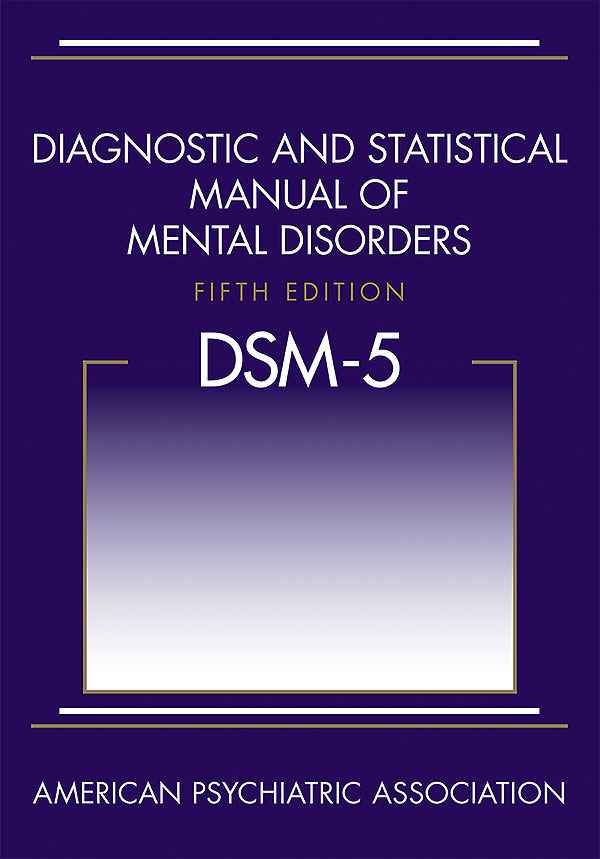Related Research Articles

The Diagnostic and Statistical Manual of Mental Disorders is a publication by the American Psychiatric Association (APA) for the classification of mental disorders using a common language and standard criteria.
Paraphilia is the experience of intense sexual arousal to atypical objects, situations, fantasies, behaviors, or individuals.
A delusion is a false fixed belief that is not amenable to change in light of conflicting evidence. As a pathology, it is distinct from a belief based on false or incomplete information, confabulation, dogma, illusion, hallucination, or some other misleading effects of perception, as individuals with those beliefs are able to change or readjust their beliefs upon reviewing the evidence.

Hypochondriasis or hypochondria is a condition in which a person is excessively and unduly worried about having a serious illness. An old concept, the meaning of hypochondria has repeatedly changed. It has been claimed that this debilitating condition results from an inaccurate perception of the condition of body or mind despite the absence of an actual medical diagnosis. An individual with hypochondriasis is known as a hypochondriac. Hypochondriacs become unduly alarmed about any physical or psychological symptoms they detect, no matter how minor the symptom may be, and are convinced that they have, or are about to be diagnosed with, a serious illness.
Ganser syndrome is a rare dissociative disorder characterized by nonsensical or wrong answers to questions and other dissociative symptoms such as fugue, amnesia or conversion disorder, often with visual pseudohallucinations and a decreased state of consciousness. The syndrome has also been called nonsense syndrome, balderdash syndrome, syndrome of approximate answers, hysterical pseudodementia or prison psychosis. The term prison psychosis is sometimes used because the syndrome occurs most frequently in prison inmates, where it may be seen as an attempt to gain leniency from prison or court officials. Psychological symptoms generally resemble the patient's sense of mental illness rather than any recognized category. The syndrome may occur in persons with other mental disorders such as schizophrenia, depressive disorders, toxic states, paresis, alcohol use disorders and factitious disorders. Ganser syndrome can sometimes be diagnosed as merely malingering, but it is more often defined as dissociative disorder.
In medicine and medical anthropology, a culture-bound syndrome, culture-specific syndrome, or folk illness is a combination of psychiatric and somatic symptoms that are considered to be a recognizable disease only within a specific society or culture. There are no objective biochemical or structural alterations of body organs or functions, and the disease is not recognized in other cultures. The term culture-bound syndrome was included in the fourth version of the Diagnostic and Statistical Manual of Mental Disorders which also includes a list of the most common culture-bound conditions. Counterpart within the framework of ICD-10 are the culture-specific disorders defined in Annex 2 of the Diagnostic criteria for research.

Marya Justine Hornbacher is an American author and freelance journalist.

Tic disorders are defined in the Diagnostic and Statistical Manual of Mental Disorders (DSM) based on type and duration of tics. Tic disorders are defined similarly by the World Health Organization.
Robert Leopold Spitzer was a psychiatrist and professor of psychiatry at Columbia University in New York City. He was a major force in the development of the Diagnostic and Statistical Manual of Mental Disorders (DSM).
The Chinese Classification of Mental Disorders, published by the Chinese Society of Psychiatry (CSP), is a clinical guide used in China for the diagnosis of mental disorders. It is currently on a third version, the CCMD-3, written in Chinese and English. It is intentionally similar in structure and categorisation to the International Classification of Diseases (ICD) and DSM, the two most well-known diagnostic manuals, though it includes some variations on their main diagnoses and around 40 culturally related diagnoses.

The classification of mental disorders is also known as psychiatric nosology or psychiatric taxonomy. It represents a key aspect of psychiatry and other mental health professions and is an important issue for people who may be diagnosed. There are currently two widely established systems for classifying mental disorders:

The Diagnostic and Statistical Manual of Mental Disorders, Fifth Edition (DSM-5), is the 2013 update to the Diagnostic and Statistical Manual of Mental Disorders, the taxonomic and diagnostic tool published by the American Psychiatric Association (APA). In the United States, the DSM serves as the principal authority for psychiatric diagnoses. Treatment recommendations, as well as payment by health care providers, are often determined by DSM classifications, so the appearance of a new version has practical importance. The DSM-5 is the first DSM to use an Arabic numeral instead of a Roman numeral in its title, as well as the first "living document" version of a DSM.
Psychiatry is the medical specialty devoted to the diagnosis, prevention, and treatment of mental disorders. These include various maladaptations related to mood, behaviour, cognition, and perceptions. See glossary of psychiatry.
Personality disorders (PD) are a class of mental disorders characterized by enduring maladaptive patterns of behavior, cognition, and inner experience, exhibited across many contexts and deviating from those accepted by the individual's culture. These patterns develop early, are inflexible, and are associated with significant distress or disability. The definitions may vary somewhat, according to source, and remain a matter of controversy. Official criteria for diagnosing personality disorders are listed in the fifth chapter of the International Classification of Diseases (ICD) and in the American Psychiatric Association's Diagnostic and Statistical Manual of Mental Disorders (DSM).
The word schizophrenia was coined by the Swiss psychiatrist and eugenicist Eugen Bleuler in 1908, and was intended to describe the separation of function between personality, thinking, memory, and perception. He introduced the term on 24 April 1908 in a lecture given at a psychiatric conference in Berlin and in a publication that same year. Bleuler later expanded his new disease concept into a monograph in 1911, which was finally translated into English in 1950.
Childhood schizophrenia is similar in characteristics of schizophrenia that develops at a later age, but has an onset before the age of 13 years, and is more difficult to diagnose. Schizophrenia is characterized by positive symptoms that can include hallucinations, delusions, and disorganized speech; negative symptoms, such as blunted affect and avolition and apathy, and a number of cognitive impairments. Differential diagnosis is problematic since several other neurodevelopmental disorders, including autism spectrum disorder, language disorder, and attention deficit hyperactivity disorder, also have signs and symptoms similar to childhood-onset schizophrenia.
A somatic symptom disorder, formerly known as a somatoform disorder, is any mental disorder that manifests as physical symptoms that suggest illness or injury, but cannot be explained fully by a general medical condition or by the direct effect of a substance, and are not attributable to another mental disorder. Somatic symptom disorders, as a group, are included in a number of diagnostic schemes of mental illness, including the Diagnostic and Statistical Manual of Mental Disorders.

The Research Domain Criteria (RDoC) project is an initiative of personalized medicine in psychiatry developed by US National Institute of Mental Health(NIMH). In contrast to the Diagnostic and Statistical Manual of Mental Disorders (DSM) maintained by the American Psychiatric Association (APA), RDoC aims to address the heterogeneity in the current nosology by providing a biologically-based, rather than symptom-based, framework for understanding mental disorders. "RDoC is an attempt to create a new kind of taxonomy for mental disorders by bringing the power of modern research approaches in genetics, neuroscience, and behavioral science to the problem of mental illness."
Sexual sadism disorder is the condition of experiencing sexual arousal in response to the extreme pain, suffering or humiliation of others. Several other terms have been used to describe the condition, and the condition may overlap with other conditions that involve inflicting pain. It is distinct from situations in which consenting individuals use mild or simulated pain or humiliation for sexual excitement. The words sadism and sadist are derived from Marquis de Sade.
Havi Hannah Carel is a professor of philosophy at the University of Bristol.
References
- 1 2 3 "Rachel Cooper". Lancaster University. Retrieved 27 August 2016.
- ↑ Cooper, Rachel (2005). Classifying Madness: A Philosophical Examination of the Diagnostic and Statistical Manual of Mental Disorders. Dordrecht: Springer. pp. i–vii.
- ↑ Tsou, Jonathan Y. (2010). "Rachel Cooper Classifying Madness: A Philosophical Examination of the Diagnostic and Statistical Manual of Mental Disorders". The British Journal for the Philosophy of Science 61 (2): 453–7. doi : 10.1093/bjps/axp057
- ↑ Double, Duncan (2006). "Review – Classifying Madness". Metapsychology Online Reviews 10 (1).
- ↑ Cooper, Rachel (2007). Psychiatry and the Philosophy of Science. Durham: Acumen.
- ↑ Cooper, Rachel (2014). Diagnosing the Diagnostic and Statistical Manual of Mental Disorders. London: Karnac.
- ↑ Goodrich, R. A. (2014). "Review – Diagnosing the Diagnostic and Statistical Manual of Mental Disorders". Metapsychology Online Reviews 18 (46).
- ↑ McGuire, Anne (2015). "Diagnosing the diagnostic and statistical manual of mental disorders". Disability & Society 30 (10): 1582–95. doi : 10.1080/09687599.2015.1062233
- ↑ Silverman, Martin A. (2015). "Diagnosing the Diagnostic and Statistical Manual of Mental Disorders. By Rachel Cooper" The Psychoanalytic Quarterly 84 (1): 239–47. doi : 10.1002/j.2167-4086.2015.00011.x
- ↑ Carel, Havi, and Rachel Cooper, eds. (2014). Health, Illness and Disease: Philosophical Essays. Oxford: Routledge.
